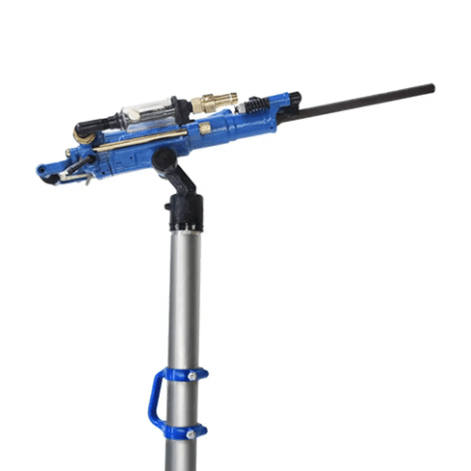Drilling through hard rock can feel like an insurmountable challenge. Whether you need to drill for construction, mining, or even a home project, the right drill bit is essential. This guide will equip you with the knowledge to select the drill bit is best suited for your task, ensuring efficiency and saving you time and frustration. We'll explore the different types of drills and bits designed to drill through rock, even the most stubborn formations.
1. Why is Drilling Through Hard Rock So Challenging, and Which Drill is Best?
The inherent density and hardness of materials like granite, basalt, and quartzite make drilling a significant undertaking. Unlike softer materials, hard rock resists penetration, requiring specialized tools and techniques. Attempting to drill with an inadequate tool can lead to frustration, broken drill bits, and wasted time. The friction generated during the drilling process can cause excessive heat, potentially damaging both the drill bit and the material. Therefore, choosing the best drill equipped with the appropriate features for hard rock is the first crucial step.
For effectively drilling through hard rock, a standard drill often lacks the necessary power and impact force. This is where specialized drills come into play. A hammer drill, for example, adds a hammering action to the rotary motion, chipping away at the rock formations. However, for truly really hard rock, a rotary hammer drill or even a pneumatic rock drill provides significantly more impact energy, making the process of creating drill holes much more efficient. The choice of drill directly impacts the effectiveness and speed at which you can drill through rock.
2. What Makes a Drill Bit Effective for Hard Rock?
A drill bit designed for hard rock possesses specific characteristics that enable it to withstand the intense forces and friction involved. The material of the cutter is paramount. Carbide is a common choice, offering excellent wear resistance and the ability to maintain its edge under high temperatures. Diamond bit technology takes it a step further, using industrial diamond particles embedded in a matrix to grind away at the rock formations. The hardness of diamond makes it exceptionally effective against even the toughest stone.
The design of the bit's tip also plays a crucial role. Aggressive cutting edges or carbide buttons help to break the rock efficiently. For larger diameter hole applications, core drill bits with diamond segments are often employed. The way the drill bit channels debris away from the cutting surface is also important to prevent clogging and overheating. Features like flutes and specialized geometries help to remove the pulverized rock, allowing the bit drills effectively. The quality of the drill bit directly translates to its ability to penetrate hard rock effectively and last longer.
3. Hammer Drill vs. Rotary Hammer: Which Rock Drill Should You Use?
While both hammer drill and rotary hammer drill incorporate a hammering action, the mechanism and power differ significantly. A hammer drill uses a clutch mechanism to create a rapid series of impacts as the drill bit rotates. This is suitable for drilling into masonry, concrete, and softer types of rock. However, the impact force of a hammer drill is generally lower, making it less efficient for really hard rock.
A rotary hammer, on the other hand, employs a piston-driven hammer mechanism that delivers a much more forceful impact directly behind the drill bit. This makes it significantly more effective at breaking up hard rock. Rotary hammer drills often come with multiple modes, including a "hammer only" mode for chiseling and demolition work. For serious rock drill applications, especially when dealing with granite or other very hard materials, a rotary hammer is generally the preferred choice. Consider the scale and hardness of your project when deciding between these two types of drills.

4. Diamond Drill Bits: Are They Always the Answer for Really Hard Rock?
Diamond drill bits are renowned for their ability to cut through extremely hard rock and other tough materials like tile and glass. The industrial diamond particles embedded in the bit act as tiny cutting edges, effectively grinding away at the material. Diamond bits work exceptionally well on really hard rock such as granite, quartz, and marble. They produce clean, accurate drill holes with minimal chipping or fracturing.
However, diamond drill bits are not always the universal solution. They typically require water cooling to prevent overheating and premature wear. This is because the friction generated can be intense, and diamond can degrade at high temperatures. You'll often see users squirt water onto the drilling surface while using a diamond bit. Also, the cost per bit is generally higher compared to carbide bits. While a diamond bit is best for certain hard rock drilling tasks, especially when precision and clean cuts are paramount, other options might be more suitable for larger holes or situations where water cooling is impractical.
5. Beyond Diamond: Exploring Other Hard Rock Drill Bit Options
While diamond drill bits excel in certain applications, other types of bits are also effective for drilling hard rock, often at a lower cost. Carbide-tipped drill bits are a common and versatile choice. The carbide inserts at the tip are incredibly hard and wear-resistant, allowing them to chip away at the rock. These masonry drill bits are widely available and can be used with both hammer drills and rotary hammers.
For drilling into softer sedimentary rocks like limestone, standard masonry bit options might suffice. However, for harder igneous and metamorphic rocks, look for heavy-duty carbide bits specifically designed for rock drill applications. Some specialized bits feature unique designs, such as multiple cutting edges or aggressive geometries, to enhance their performance in hard rock. When selecting, consider the type of rock you're working with and the specific requirements of your project. There are many drill bits available beyond diamond that can effectively drill through rock.
6. Understanding Core Drilling and When a Core Drill Would Be Necessary
Core drilling is a specialized technique used to create large, precise diameter hole while removing a cylinder of material, known as the core. Instead of pulverizing the entire area of the hole, a core drill cuts a circular path. This is particularly useful when you need to extract a sample of the rock or when creating large openings for pipes or conduits. A core drill typically uses a cylindrical drill bit with diamond segments embedded in the cutting edge.
When dealing with hard rock and needing larger diameter holes, a core drill would be significantly more efficient than trying to create the same size hole with a standard bit. Imagine needing a hole several inches in diameter; a core drill tackles this directly. Core drills often require a stable setup, such as a drill press or a handheld core drilling rig, and typically use water cooling to manage heat and dust. If your project requires large, clean holes in concrete or hard rock, a core drill is the appropriate tool.
7. What Size Drill Bit Do I Need? A Guide to Diameter and Hole Size
Choosing the correct diameter of your drill bit is crucial for achieving the desired results. The size of the drill bit directly corresponds to the size of the drill holes you will create. Drill bits come in a variety of sizes, typically measured in inches or millimeters. The size you need will depend entirely on the specific requirements of your project. If you're drilling pilot holes for anchors, the size will be determined by the anchor specifications. For creating passages for pipes or wires, the diameter needs to accommodate the object passing through.
Always double-check the required hole size before you begin drilling. Using a drill bit that is too small will require you to re-drill, while using one that is too large can compromise the integrity of the material or the fit of fasteners. Many manufacturers provide size guide information for their products. When in doubt, it's often better to start with a slightly smaller drill bit and incrementally increase the size if needed. Remember, the diameter of the drill bit dictates the final diameter hole.
8. Techniques for Success: How to Drill Holes Efficiently in Hard Rock
Drilling efficiently in hard rock requires more than just the right drill bit; proper technique is essential. Start by marking the precise location where you need to drill. Use a center punch to create a small indentation; this prevents the drill bit from wandering when you start. Apply consistent, firm pressure to the drill. Let the bit do the work; forcing it can lead to overheating and damage.
For deeper drill holes, periodically withdraw the drill bit to clear debris from the hole. This prevents the bit from binding and reduces friction. Using water or a coolant is highly recommended, especially with diamond bits, to cool the bit and remove cuttings. Maintain a steady speed; excessive speed can generate too much heat, while too slow a speed can be inefficient. If the drill bit gets stuck, do not force it. Try reversing the drill slowly to dislodge it. Patience and a steady approach are key to successfully drilling through hard rock.
9. Maintaining Your Drill Bit for Longevity and Performance
Proper maintenance is crucial for extending the life of your drill bits, especially those designed for hard rock. After each use, clean the drill bit thoroughly to remove any rock dust or debris. This prevents corrosion and ensures the cutting edges remain sharp. Inspect the bit for any signs of damage, such as chipped or worn cutting edges.
Store your drill bits in a dry place to prevent rust. Consider using a drill bit index or case to keep them organized and protected. For carbide bits, professional sharpening services can restore their cutting edge. Diamond bits, while not sharpenable in the traditional sense, can sometimes have their cutting efficiency improved by exposing fresh diamond particles. Investing in quality drill bits and taking care of them will save you money in the long run by reducing the need for frequent replacements. A well-maintained drill bit will perform better and last longer.
10. Where to Buy Drill Bits for Hard Rock: Home Depot, or Specialist Suppliers?
When purchasing drill bits for hard rock, you have several options. Big box stores like Home Depot offer a wide variety of sizes and types of drill bits, including masonry drill bits and some diamond options. This can be a convenient option for general use and readily available bits. However, for specialized hard rock drilling needs, particularly when dealing with really hard rock or requiring specific core drill sizes, a specialist supplier might be a better choice.
Specialist suppliers often carry a more extensive selection of high-quality drill bits designed for demanding applications. They can also provide expert advice on selecting the right type of bit for your specific rock formations. Brands like Hilti and Bosch are known for their high-performance drill bits. Consider the scale and complexity of your project when deciding where to purchase your drill bits. While Home Depot offers convenience, specialist suppliers often provide a wider range of options and expert guidance.
Key Takeaways:
- Drilling through hard rock requires specialized drills and drill bits.
- Rotary hammers are generally more effective than hammer drills for really hard rock.
- Diamond drill bits are excellent for clean, precise cuts but often require water cooling.
- Carbide-tipped bits are a versatile and cost-effective option for many hard rock applications.
- Core drills are necessary for creating large diameter hole and extracting core samples.
- Proper drilling technique, including consistent pressure and cooling, is crucial for success.
- Regular maintenance will extend the life and performance of your drill bits.
- Consider specialist suppliers for a wider selection of high-performance drill bits.
For all your drilling needs, including high-quality drill bits, explore our range of rock drilling bits. Ensure a secure setup with our reliable shank adapters and consider our durable self-drilling hollow anchor systems for related projects.
Post time: 1 月-06-2025














